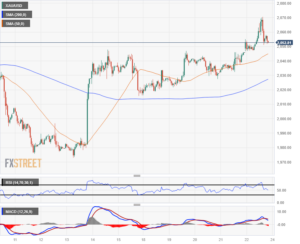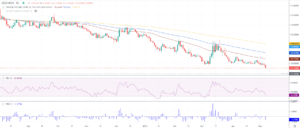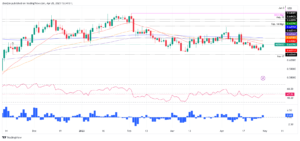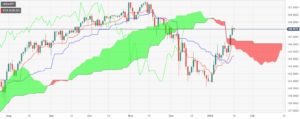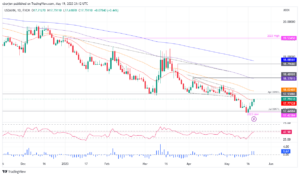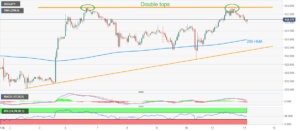- Standard & Poor’s 500 index has gained for five consecutive weeks.
- US Treasury yields rise more than 1% along much of the curve.
- Friday’s Nonfarm Payrolls report is the primary data release this week.
- Uber Technologies is set to join the index on December 18.
- Earnings arrive from Autozone, Nio, GameStop, Broadcom, Lululemon and Dollar General.
The S&P 500 index opened closed down 0.54% on Monday, while the NASDAQ Composite lost 0.84% and the Dow Jones receded 0.11%. The S&P 500 index gained in each of the past five weeks. The market awaits earnings after the close from Gitlab (GTLB).
The index sits just shy of the yearly high at 4,607, and while gains have become lighter in the last two weeks, it still seems possible that the S&P 500 will mark a new annual high before the year is out.
US Treasury yields rose on Monday, a fact that has led equities to slide at the start of the week. The 12-month through 10-year all saw yields jump more than 1% on Monday.
Uber Technologies (UBER) has received notice that it will join the S&P 500 on December 18, and shares of the rideshare company have spiked. Apple (AAPL) is placing a put on the index as it momentarily shutters production in India of its iPhone due to torrential rains.
Most of the market is focused on US jobs figures this week as the November Nonfarm Payrolls data gets released this Friday. Additionally, earnings from Broadcom, Lululemon and Autozone will catch eager ears throughout the week. This is in addition to GameStop (GME) , Nio (NIO) and Dollar General (DG).
S&P 500 News: Uber to join index
UBER stock gained more than 5% at the beginning of Monday, rising above $60 for the first time since April 2021. The rideshare or mobility company has managed to leave behind years of losses as CEO Dara Khosrowshahi has placed it on a trajectory of rising profitability. That newfound profitability has allowed it to finally be accepted into the S&P 500.
Uber stock will gain in price ahead of the index inclusion since index managers are forced to buy shares in the leadup to its official debut on December 18 – just two weeks from now.
Analysts have also had a lot of positive commentary for the stock. Oppenheimer raised its price target to $75 on UBER stock as S&P 500 inclusion marks a new era for the company. Argus raised its price target to $69. Both analysts expect UBER to enter the buyback game with its newfound focus on profitability.
"Following the inclusion, we expect UBER to lean into growth and share buybacks, which should increase investor sentiment for growth/ return in 2024," wrote Oppenheimer analyst Jason Helfstein.
Argus estimated that Uber will earn $1.54 per share in 2024 on $47.1 billion in revenue.
Earnings collide with Nonfarm Payrolls for a busy first week of December
Before November’s much-watched jobs report comes on Friday, several big-name firms will report earnings on the back end of a winding down earnings season.
Broadcom (AVGO) is arguably the most important of these companies. The stock is up more than 67% year to date and has recently received its final go-ahead from important global regulators in order to finalize its acquisition of VMWare.
After the market closes on Thursday, Broadcom is expected to deliver adjusted EPS of $10.96 on revenue of $9.28 billion.
Lululemon (LULU) will compete with Broadcom for eyeballs late Thursday. It is slated to report consensus adjusted EPS of $2.28 on $2.19 billion in sales. The activewear brand nearly always beats the consensus, but the stock has received two earnings revisions in the past few months for the reporting quarter.
Autozone (AZO) on Monday is expected to earn $31.57 in adjusted EPS on $4.19 billion in sales. Both of these figures demonstrate healthy growth over the same quarter a year ago, but analysts are mixed based on earnings revisions for the quarter.
Then on Friday, investors will turn their gaze toward the November Nonfarm Payrolls report. A number under 200K will delight the market as labor market weakness is thought necessary to appease the Federal Reserve. Investors have started to take bets on a central bank rate cut at either the March or May meetings. At the moment, the May meeting is the favorite by a long shot.
Consensus calls for 180K net new hires on Friday, which comes after October’s 150K number. A figure too far below 150K might worry the market that a hard landing has finally begun. The Unemployment Rate is expected to stand still at 3.9%.
Dow Jones FAQs
The Dow Jones Industrial Average, one of the oldest stock market indices in the world, is compiled of the 30 most traded stocks in the US. The index is price-weighted rather than weighted by capitalization. It is calculated by summing the prices of the constituent stocks and dividing them by a factor, currently 0.152. The index was founded by Charles Dow, who also founded the Wall Street Journal. In later years it has been criticized for not being broadly representative enough because it only tracks 30 conglomerates, unlike broader indices such as the S&P 500.
Many different factors drive the Dow Jones Industrial Average (DJIA). The aggregate performance of the component companies revealed in quarterly company earnings reports is the main one. US and global macroeconomic data also contributes as it impacts on investor sentiment. The level of interest rates, set by the Federal Reserve (Fed), also influences the DJIA as it affects the cost of credit, on which many corporations are heavily reliant. Therefore, inflation can be a major driver as well as other metrics which impact the Fed decisions.
Dow Theory is a method for identifying the primary trend of the stock market developed by Charles Dow. A key step is to compare the direction of the Dow Jones Industrial Average (DJIA) and the Dow Jones Transportation Average (DJTA) and only follow trends where both are moving in the same direction. Volume is a confirmatory criteria. The theory uses elements of peak and trough analysis. Dow’s theory posits three trend phases: accumulation, when smart money starts buying or selling; public participation, when the wider public joins in; and distribution, when the smart money exits.
There are a number of ways to trade the DJIA. One is to use ETFs which allow investors to trade the DJIA as a single security, rather than having to buy shares in all 30 constituent companies. A leading example is the SPDR Dow Jones Industrial Average ETF (DIA). DJIA futures contracts enable traders to speculate on the future value of the index and Options provide the right, but not the obligation, to buy or sell the index at a predetermined price in the future. Mutual funds enable investors to buy a share of a diversified portfolio of DJIA stocks thus providing exposure to the overall index.
Earnings of the week
Monday, December 4 - GitLab (GTLB)
Earnings spotlight: Tuesday, December 5 - AutoZone (AZO), Toll Brothers (TOL), MongoDB (MDB), NIO (NIO), JM Smucker (SJM)
Wednesday, December 6 - Brown-Forman (BF.A), Campbell Soup (CPB), C3.ai (AI), Chewy (CHWY), GameStop (GME), ChargePoint Holdings (CHPT)
Thursday, December 7 - Broadcom (AVGO), Lululemon (LULU), Dollar General (DG), DocuSign (DOCU)
What they said about the market – Michael Hartnett
Michael Hartnett, a strategist at Bank of America Securities, holds to the firm’s belief that the S&P 500 index will end next year at 5,000 – a new all-time high. Hartnett believes that the market is at an emotionally bullish inflection point and will rally into Valentine’s Day. Second, US presidential election years are normally good for the stock market.
“Our parachute in 2024 is the politics: elections means stimulus, and that means the landing will be soft not hard.”
S&P 500 forecast
In November the S&P 500 blew right through the 4,541 resistance point stemming from the lower high on September 1. However, there are two other historical resistance levels in close succession. These are the July 27 annual high at 4,607 and then the 4,607 level from March 2022. Both of these resistance levels must be overcome in order to reach the 4,800 all-time high from December 2021.
The Moving Average Convergence Divergence (MACD) indicator, however, looks ready for a bearish crossover. Five weeks of gains need to be broken at some point, and this looks like the week to do it. The Relative Strength Index (RSI) – not shown in the graph below – has broken lower to a reading of 66 on Monday after several weeks of drifting within overbought territory.
A shakeout here could send the index back to the 4,541 level or even the 100-day Simple Moving Average (SMA), which currently sits at 4,420.
S&P 500 daily chart
- SEO Powered Content & PR Distribution. Get Amplified Today.
- PlatoData.Network Vertical Generative Ai. Empower Yourself. Access Here.
- PlatoAiStream. Web3 Intelligence. Knowledge Amplified. Access Here.
- PlatoESG. Carbon, CleanTech, Energy, Environment, Solar, Waste Management. Access Here.
- PlatoHealth. Biotech and Clinical Trials Intelligence. Access Here.
- Source: https://www.fxstreet.com/news/sp-500-forecast-index-falls-on-monday-as-treasury-yields-rise-after-five-weeks-of-gains-202312041855
- :has
- :is
- :not
- :where
- ][p
- $UP
- 000
- 1
- 152
- 19
- 2021
- 2022
- 2024
- 27
- 28
- 30
- 33
- 35%
- 420
- 500
- 54
- 66
- 7
- a
- About
- above
- accepted
- accumulation
- acquisition
- addition
- Additionally
- Adjusted
- After
- aggregate
- ago
- ahead
- AI
- All
- allow
- allowed
- along
- also
- always
- america
- an
- analysis
- analyst
- Analysts
- and
- Animate
- annual
- April
- ARE
- arguably
- AS
- At
- average
- back
- Bank
- Bank of America
- Bank Rate
- based
- BE
- bearish
- because
- become
- been
- before
- Beginning
- begun
- behind
- being
- belief
- believes
- below
- Bets
- Billion
- both
- brand
- Broadcom
- broader
- broadly
- Broken
- brothers
- Bullish
- busy
- but
- buy
- Buyback
- Buying
- by
- calculated
- Calls
- CAN
- capitalization
- Catch
- central
- Central Bank
- ceo
- Charles
- chewy
- Close
- closed
- Closes
- Collide
- comes
- Commentary
- Companies
- company
- compare
- compete
- compiled
- component
- consecutive
- Consensus
- constituent
- content
- contracts
- contributes
- Convergence
- Corporations
- Cost
- could
- credit
- criteria
- Currently
- curve
- Cut
- daily
- Dara Khosrowshahi
- data
- Date
- day
- December
- december 2021
- decisions
- delight
- deliver
- demonstrate
- developed
- dia
- different
- direction
- distribution
- Divergence
- diversified
- diversified portfolio
- djia
- do
- DocuSign
- Dollar
- dow
- Dow Jones
- Dow Jones Industrial Average
- down
- drive
- driver
- due
- each
- eager
- earn
- Earnings
- Earnings season
- either
- Election
- Elections
- elements
- enable
- end
- ends
- enough
- Enter
- Era
- estimated
- ETF
- ETFs
- Ether (ETH)
- Even
- example
- exits
- expanded
- expect
- expected
- Exposure
- fact
- factor
- factors
- FAQ
- far
- Favorite
- Fed
- Federal
- federal reserve
- few
- Figure
- Figures
- final
- finalize
- Finally
- firms
- First
- first time
- five
- Focus
- focused
- follow
- following
- For
- Founded
- Friday
- from
- funds
- future
- Futures
- Gain
- gained
- Gains
- game
- GAMESTOP
- General
- Global
- good
- graph
- Growth
- had
- Half
- Hard
- Have
- having
- healthy
- heavily
- here
- High
- hires
- historical
- Holdings
- holds
- However
- HTTPS
- identifying
- Impact
- Impacts
- important
- in
- inclusion
- Increase
- index
- india
- Indicator
- Indices
- industrial
- inflation
- Inflection
- Inflection Point
- interest
- Interest Rates
- into
- investor
- investor sentiment
- Investors
- iPhone
- IT
- ITS
- Jobs
- jobs report
- join
- Joins
- jones
- journal
- jpg
- July
- jump
- just
- Key
- labor
- labor market
- landing
- Last
- Late
- later
- leading
- Leave
- Led
- Level
- levels
- lighter
- like
- Long
- LOOKS
- Loses
- losses
- lost
- Lot
- lower
- MACD
- Macroeconomic
- Main
- major
- managed
- Managers
- many
- March
- mark
- Market
- May..
- means
- meeting
- meetings
- method
- Metrics
- Michael
- might
- mixed
- mobility
- module
- moment
- Monday
- money
- MongoDB
- months
- more
- most
- moving
- moving average
- much
- must
- mutual
- mutual funds
- Nasdaq
- nearly
- necessary
- Need
- net
- New
- news
- nio
- Nonfarm
- Nonfarm Payrolls
- normally
- Notice..
- November
- now
- number
- obligation
- of
- official
- oldest
- on
- ONE
- only
- opened
- Options
- or
- order
- Other
- out
- over
- overall
- Overcome
- participation
- past
- Payrolls
- Peak
- per
- percentage
- performance
- placed
- placing
- plato
- Plato Data Intelligence
- PlatoData
- Point
- politics
- portfolio
- positive
- possible
- presidential
- presidential election
- price
- Prices
- primary
- Production
- profitability
- provide
- providing
- public
- put
- Quarter
- raised
- rally
- Rate
- Rates
- rather
- reach
- Reading
- ready
- received
- recently
- Regulators
- relative
- relative strength index
- Relative Strength Index (RSI)
- release
- released
- report
- Reporting
- Reports
- representative
- Reserve
- Resistance
- return
- Revealed
- revenue
- revisions
- right
- Rise
- rising
- ROSE
- rsi
- S&P
- S&P 500
- Said
- sales
- same
- saw
- Season
- Second
- Securities
- security
- seems
- sell
- Selling
- send
- sentiment
- September
- set
- several
- Share
- Shares
- shot
- should
- shown
- Simple
- since
- single
- sits
- Slide
- SMA
- smart
- Soft
- some
- Spotlight
- stand
- start
- started
- starts
- Step
- Still
- stimulus
- stock
- stock market
- Stocks
- Strategist
- street
- strength
- such
- Take
- Target
- Technologies
- territory
- than
- that
- The
- the Fed
- The Future
- The Graph
- The Wall Street Journal
- the world
- their
- Them
- then
- theory
- There.
- therefore
- These
- they
- this
- this week
- thought
- three
- Through
- throughout
- thursday
- Thus
- time
- to
- too
- toward
- trade
- traded
- Traders
- trajectory
- transportation
- treasury
- Treasury yields
- Trend
- Trends
- Tuesday
- TURN
- two
- Uber
- under
- unemployment
- unemployment rate
- unlike
- us
- use
- uses
- value
- vmware
- volume
- Wall
- Wall Street
- Wall Street Journal
- was
- ways
- we
- weakness
- week
- Weeks
- WELL
- when
- which
- while
- WHO
- wider
- will
- with
- within
- world
- worry
- wrote
- year
- yearly
- years
- yields
- zephyrnet




